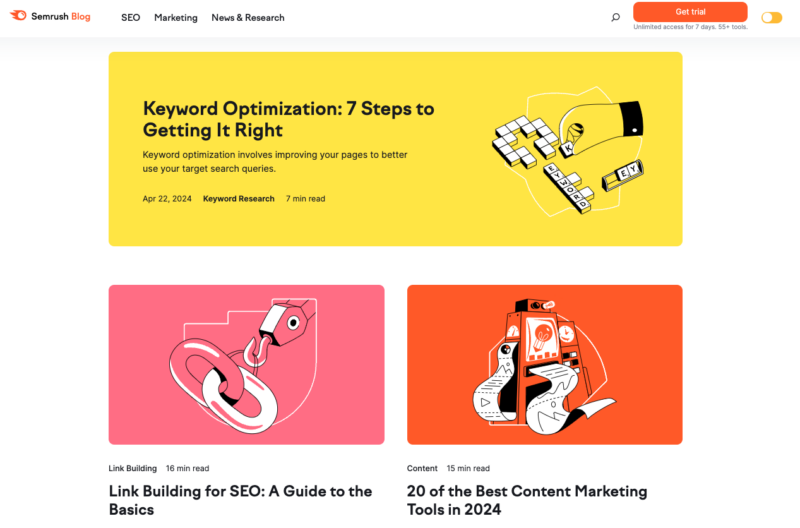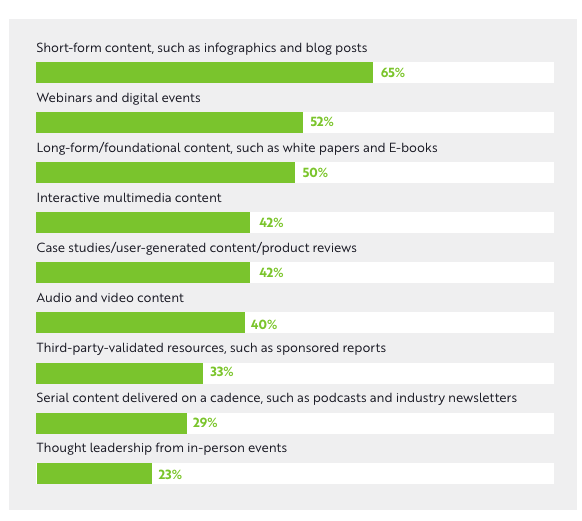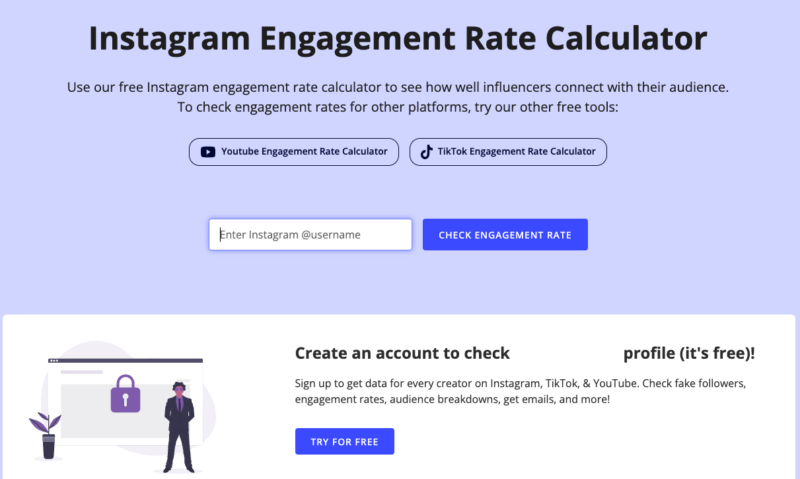How to Build a Lead-Generating B2B Content Marketing Strategy

Key Takeaways
- Quality and purpose trump volume—each asset must guide prospects through the buyer’s journey.
- Effective B2B content marketing targets lead generation and customer conversion
- Lead generation involves multiple channels and touchpoints, from content to events.
- Personalized content and tailored messaging are essential for nurturing high-quality leads.
- Understanding buyer personas and enterprise profiles improves targeting and conversion.
- Repurposing content across platforms maximizes reach and reinforces brand messaging.
- Clear CTAs and easy-to-consume formats drive engagement and facilitate seamless conversions.
Publishing five or even 15 pieces of content a month may keep your website fresh, but it won’t necessarily move the needle.
Each content asset you create needs to serve a purpose. Every blog post, every ebook, and every webinar should work together to guide prospects through the buyer’s journey and nurture them toward a sale.
The most effective B2B content marketing strategies focus on the end goal: driving high-quality leads into the pipeline and converting them into customers.
In this article, we’ll explore lead generation tactics to help you create a content plan that nurtures them at every stage of the buying process.
What is B2B Lead Generation?
How Does Content Marketing Fit into the Equation?

Scaling Marketing: 16 Strategies to Drive Greater Growth
Uncover 16 Strategies to Drive Greater Business Growth Read the Post9 Content Marketing-Focused Lead Generation Strategies
Advanced B2B Content Marketing Strategies
Drive greater leads and pipeline through precision-engineered SEO, content, and conversion optimization. Book a Strategy Call4. Make Content Easy to Consume
B2B buyers are increasingly selective about the content they choose to engage with. With so much noise competing for their attention, marketing teams need to adapt their B2B marketing strategies to make every asset as accessible and valuable as possible.
One key consideration is whether to gate content behind a form. While gating captures leads, it also creates friction. Unless an asset offers exclusive insights that can’t be found elsewhere, many buyers won’t bother filling out a form.
For example, gating an ebook makes little sense if your competitors offer blogs on the same topic without any barriers. The payoff just isn’t there for time-pressed readers.
At the same time, you don’t want to invest in content where the return over time spent is minimal.
For example: if your webinar drones on for an hour without providing any substantive takeaways, attendees will tune out quickly. They’ll be frustrated that they wasted their time and will be less likely to engage with your brand’s content in the future.
That’s why it’s so crucial to prioritize quality over quantity when it comes to content creation. Every asset you produce should be laser-focused on providing tangible value to your target audience. And make it interactive.
B2B buyers currently love these content types:
Some best practices to maximize content consumption:
- Focus on scannable layouts with bulleted lists, brief paragraphs, pull quotes, and sidebar summaries to enable skimming.
- Use strong visuals like infographics, charts, images, and videos to convey information at a glance.
- Keep the copy concise and cut to the chase quickly. Buyers don’t have the patience for fluff.
- Ensure content is mobile-friendly and fast-loading for on-the-go access.
- Provide added context with jump links, hover-over definitions, or content hubs that connect related assets.
The takeaway for marketers? Prioritize ungated content in the formats your audience gravitates to most. Make it as effortless as possible for buyers to access and digest your insights.
5. Align Content Types with the Buyer’s Journey
One size definitely doesn’t fit all when it comes to creating content (especially with the risks of AI-generated content).
Buyers have very different informational needs and priorities depending on where they are in their decision-making process.
Here’s the dead-simple truth: your buyers are completing jobs and you need to create content that matches those jobs.
The key throughout the journey is to provide the right information at the right time in the formats your buyers prefer. In industries like B2B fintech marketing, mapping your content to each stage creates a seamless, supportive buying experience that builds trust and drives conversions.
The graphic below from one of our content writers, Kiran Shahid, summarizes the content types you can create based on your buyer’s current activities.
It really isn’t as complicated. Here are five tips for executing this:
- Develop detailed buyer personas to understand the unique needs and preferences of your target audience at each stage.
- Conduct keyword research to identify the specific terms and questions buyers are searching for at each phase.
- Create content hubs or resource centers that organize assets by buying stage, making it easy for buyers to self-serve.
- Use marketing automation to deliver stage-specific content to buyers based on their behaviors and engagement levels.
- Continuously gather feedback and analytics to refine your content marketing strategy over time.
Ultimately, the goal is to provide a helpful, tailored content experience that empowers buyers to make confident decisions. Be intentional about the types of content you create and when you deliver them.
6. Invest in Original Research
Research reports are in-depth analyses based on original data, often from surveys, that provide new insights or benchmarks on a particular topic.
For example, Sprout Social’s “The 2024 Influencer Marketing Benchmarks Report” shares original data and trends about the current state and best practices of influencer marketing.
The Content Marketing Institute highlights that 43% of B2B marketers consider research reports the most effective type of content.
Why? Because original research builds thought leadership and credibility in a way that other content can’t. It positions your brand as a leading expert by sharing new, authoritative information.
Plus, 52% of B2B buyers are more likely to share content that’s packed with shareable stats and quick-hitting facts.
The main hesitation with investing in original research, though, is often the significant time, effort, and budget required. Conducting a major research project isn’t easy or cheap.
However, Michelle Linn, founder of Mantis Research, highlights that a single research study can fuel many different initiatives. You can repurpose the same findings into sales assets, PR talking points, blog posts, guest articles, social content, and more.
So while original research requires upfront investment, it can pay off in multiple ways. Not only does it elevate your brand authority, but it also becomes an asset that keeps providing value over time.
If it aligns with your goals and resources, original research can be a powerful differentiator for your content marketing. It’s a credibility-builder that keeps on giving.
7. Engage in Social Selling on LinkedIn
Social selling involves using social media platforms to find, connect with, and nurture potential customers. It’s about meeting buyers where they are and engaging them with relevant, high-quality content and conversations.
On platforms like LinkedIn, social selling involves:
- Optimizing your profile to showcase your expertise and build credibility
- Sharing helpful, educational content that addresses your target audience’s needs
- Engaging in conversations and building relationships with potential buyers
- Using your network for warm introductions and referrals
- Monitoring key accounts’ activity and engaging with their content
Why is social selling so important? Because it works. LinkedIn’s research shows that social selling leaders are 51% more likely to reach quota than those who don’t embrace this approach.
The benefits are clear:
- Increased brand awareness and reach within your target market
- More high-quality leads are generated through genuine, trusted relationships
- Higher conversion rates as leads are nurtured with personalized, relevant content
- More organic traffic driven to your website and other owned channels
- Deeper insights into your buyers’ needs, challenges, and interests
Ultimately, social selling allows you to build a pipeline of qualified leads who know and trust your brand before they ever talk to a salesperson.
A great example of social selling in action is our team at Stratabeat. Most of us—including our founder, Tom Shapiro, and Chief Growth Officer, Alexis Trammell, are active on LinkedIn.
We share thought-provoking posts on industry topics, engage in conversations with potential customers, and showcase our unique approach through educational content. This helps us build brand awareness, establish thought leadership, and attract high-quality leads.
By having multiple voices from the company engaged on LinkedIn, we create more touchpoints and opportunities to connect with potential buyers. This way, we become a familiar, trusted presence in our prospects’ feeds.
It’s less about pitching and more about positioning yourself as a trusted partner. Share content that educates and inspires. Join conversations where you can lend unique insights. Build real, human connections.
8. Optimize Your Content to Increase Conversions
You could have the most brilliant, insightful content in the world, but if it doesn’t drive readers to take action, it’s not fulfilling its potential.
Every piece of content should have a clear purpose and desired outcome. Whether it’s signing up for a free trial, downloading a whitepaper, or booking a demo, your content should guide readers toward that goal with relevant, compelling calls-to-action (CTAs).
Hotjar, a user behavior analytics tool, provides a great example of this in action. Their blog post on using heatmaps to improve UX ends with a natural CTA encouraging readers to set up a heatmap using Hotjar.
Other ways to optimize content for conversions include:
- Placing CTAs throughout the content, not just at the end. This captures readers at different stages of engagement.
- Using action-oriented language that creates a sense of urgency, like “Sign up now” or “Get your free template”.
- Offering content-specific offers or resources, like a related ebook or tool, to provide additional value and capture lead info.
- A/B testing different CTA placements, wordings, and designs to optimize performance over time.
Another way to capture leads is through gated content.
Yes, we’ve cautioned against gating for gating’s sake. But there’s still a place for high-value, exclusive content that justifies the “price” of providing contact information.
Using their Instagram Engagement Rate Calculator, influencer marketing platform Modash illustrates this well.
To access this unique users need to sign up. The calculator’s exclusivity and utility make the information exchange worthwhile.
Similarly, resources like templates, checklists, and original research reports can be excellent lead magnets. These high-value assets are often difficult to find elsewhere, so subscribers are more willing to “pay” for access with their email address.
Every element of your content should work together towards that goal—the insights you provide, the CTAs you include, the design and user experience.
9. Repurpose Content for Different Distribution Channels
B2B buyers consume content across a wide range of platforms—from social media channels to podcasts to email newsletters.
Reaching decision-makers requires meeting them where they are.
Why is this multi-channel approach so important? Because it provides multiple touchpoints for potential customers to discover and connect with your brand.
The more times they discover your helpful, relevant content, the more likely they are to remember you when it comes time to make a purchasing decision.
However, simply copy-pasting the same content across every channel won’t work. Each platform has its own unique audience, format, and best practices.
You need to create platform-native content that fits into their feed and consumption habits.
Superpath, a content marketing community, provides a great example of this with their podcast, “Content, Briefly.” To promote the latest episode, co-founder Jimmy Daly didn’t just share a link to the podcast.
Instead, he posted a short video snippet from the episode on LinkedIn, accompanied by a text summary. Then, he dropped the full podcast link in the comments for those who wanted to dive deeper.
Visual, easily digestible format catches LinkedIn scrollers’ attention. This multi-format approach allows Superpath to engage LinkedIn users in the way they prefer, while still driving traffic back to the core podcast content.
Other examples of repurposing content for different channels include:
- Turning a blog post into an X thread: Break down the key points into short, punchy posts that potential leads can share and engage with.
- Adapting a whitepaper into a LinkedIn carousel post: Distill the main insights into a slideshow format that’s native to LinkedIn.
- Creating short video content for TikTok or Instagram Reels: Showcase quick tips or highlights from longer-form content in a snappy, attention-grabbing way.
- Repurposing webinar content into an email drip campaign: Break the key lessons into a series of emails that provide value and drive registrations for the full webinar recording.
- Turning customer interviews into case study blog posts: Adapt the conversation into a narrative that showcases your product’s value and impact.
Think about how to repackage your core content themes and messages that work for each specific platform.
Content atomization or content repurposing across channels maximizes your reach and impact without starting from scratch each time. You’ll provide a cohesive brand experience while still tailoring your approach to each unique audience.
Attract Your Ideal Customers with an Integrated Approach
FAQs
It’s a strategy focused on creating and distributing valuable, relevant content specifically for other businesses to educate, engage, and nurture leads.
Valuable content builds trust, establishes your brand as an industry authority, and drives qualified leads through the sales funnel.
Strategic efforts ensure every piece of content aligns with your business goals, maximizes ROI, and moves prospects through the customer journey.
Successful content marketers will typically begin to see results from your content marketing efforts within 3-6 months, with significant gains compounding over time as your content builds authority and organic search visibility.
Create high-quality, data-driven, and personalized content that directly addresses your target audience’s pain points and differentiates your brand.
Use tools like Google Analytics, SEO platforms, and social media metrics to monitor key performance indicators such as traffic, engagement, and conversions.
Keep up with industry trends and industry experts, continuously test new content formats, monitor market shifts, and refine your strategy based on data-driven insights.
B2C content marketing fuels quick emotional engagement and impulse purchases, while B2B content builds trust, educates, and nurtures long-term relationships.
It depends on your content marketing plans. Take a look at Stratabeat’s pricing page or book a strategy call with us to chat about your content marketing goals and investment.

















